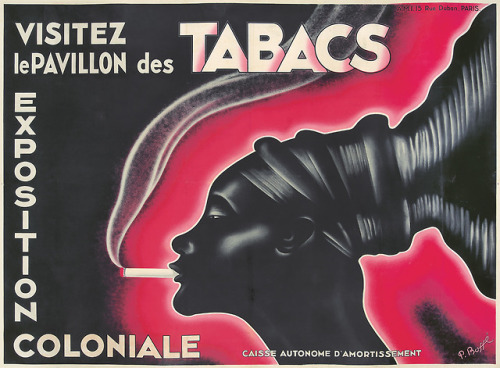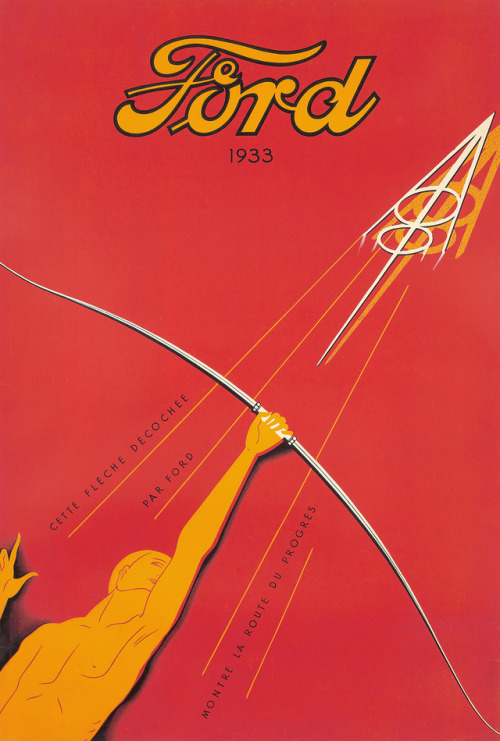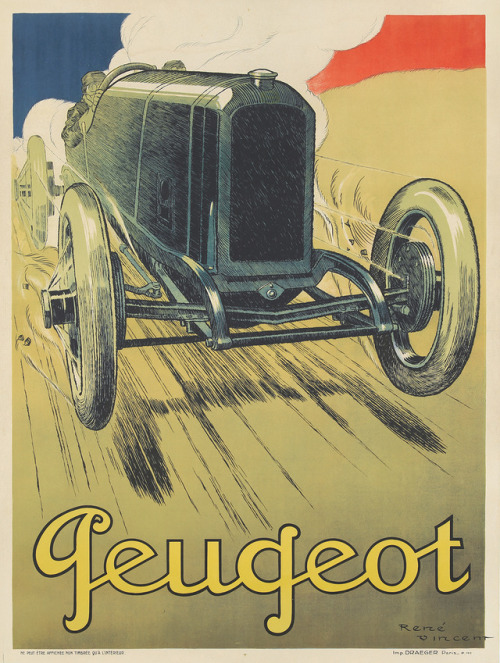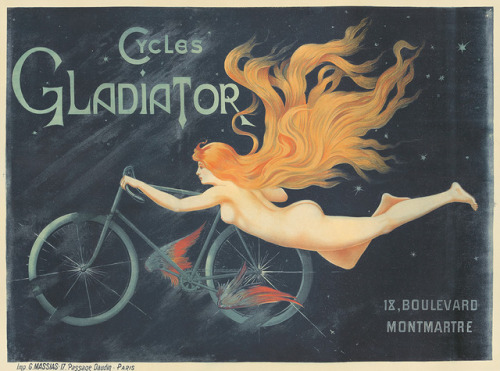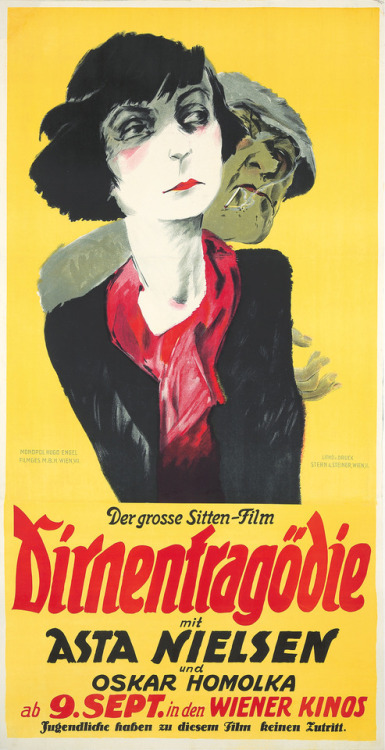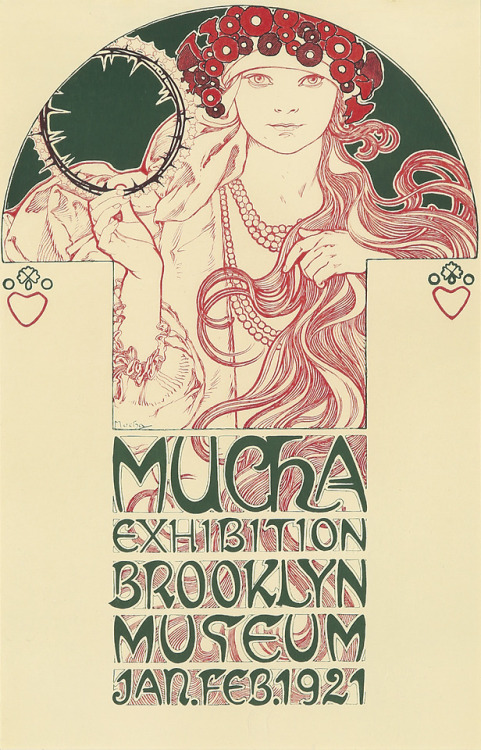#vintage posters
Pavillion des Tabacs. 1931. P. Bosse.
78 3/8 x 57 ¼ in./199 x 145.4 cm
An electric-pink neon glow surrounds a stylized bust of a smoking African woman in a convergence of modern and traditional aesthetics. The Exposition Coloniale of Paris, held in 1931, attempted to paint France’s colonial empire in a positive light by demonstrating mutually beneficial cultural exchange. The expo attracted between 7 and 9 million visitors from around the world.
Available at auction June 26. Learn More>>
Post link
Modiano. 1933. Franz Lenhart.
39 1/8 x 55 in./99.3 x 139.6 cm
For the Modiano brand of prefabricated rolling paper tubes, Lenhart plays us an engaging optical game of silhouettes: the black outfit of the Garbo-like femme fatale like a cutout against the green background, the blouse and the hand cut out in turn from the black; standing out from both, the warmly glowing face and the white cigarette. Most elegant! Born in Bavaria, Lenhart studied in Italy and settled there permanently in 1922 to work and teach.
Post link
Philippossian Automobiles. 1920. Charles Loupot.
50 ¾ x 35 3/8 in./128.8 x 90 cm
A flame-haired Femme Fatale, dressed in black, launches this midnight-blue beast of an auto into the foggy night: a masterpiece! Exceptionally rare, this poster finds Loupot at the absolute apex of his transition period between Switzerland and France, between domestic traditionalism and aggressive Modernist experimentation. According to Loupot’s son, Jean-Marie, until this point Loupot was hired by printers; this was likely his first direct commission from the advertiser (alongside his wildly successful Philippossian Cigarettes, see PAI-LXX, 443). The typeface, with which he’d been experimenting with since at least the previous year (see “Plantol,” PAI-XXI, 270) now achieves a refined state of Deco precision. This poster appears to be the sole remnant of any flirtation the advertiser Charles Philippossian had with the auto industry. However, it’s clear that the brilliance of this piece served as Loupot’s introduction to an entirely new market, as a creator of the new Art Deco aesthetic. In the following years, he’d create superb work for Swiss Grand Prix autos and motorcycles; Austin Tractors; and Voisin Autos, before defining the industrial Art Deco aesthetic at the 1925 Expo, and with classics such as “Stop-Fire.” An important work by this artist. Exceptionally rare.
Post link
Salmson. ca. 1929. Alexis Kow.
42 ¾ x 62 5/8 in./108.6 x 159 cm
Salmson began as a manufacturer of water-cooled airplane engines. Consequently, the poster boasts that the car has the precision of these airplane motors. Their first automobiles appeared in 1921, and graduated from amusing cyclecars to sports cars, and from there to majestic luxury sedans like this one. In 1925, Salmson won 76 races and set 14 speed records for its class. Russian-born Kow created smart and sleek automobile print advertisements and posters. Here, he makes effective use of strong, flat colors, with the Salmon insignia shining above, as the blurry whir of a plane engine spins in the background.
Available at auction June 26. Learn more >>
Post link
Ford. 1933. Anonymous.
30 5/8 x 45 ¾ in./77.8 x 116.2 cm
“Ford introduced the V-8 engine in 1932, and this poster for the following year’s model showcases its promotional message ("Ford lets fly this arrow to show the road of progress”) with a striking Art Deco take on classicism. Ford was the first company to cast a V-8 engine block in one piece. It was many years before the company’s competitors learned how to mass-produce a reliable V-8; in the interim, the car and its powerful engine became the preferred choice of performance-minded motorists worldwide" (Crouse/Deco, p. 46).
Available at auction June 26. Learn more >>
Post link
Peugeot. 1900. Rene Vincent.
46 5/8 x 61 ½ in./118.5 x 156.2 cm
This absolute monster of a chassis, careening out of a Tricoleur sky, bounding along with wheels in the air, is not exactly correct. It appears to be a hybrid of the 1913 and the 1916 Peugeots, which each won the Indianapolis 500: the wishbone front suspension is 1916; the configuration of the chassis, more 1913; but the actual artifacts have a slight upward curve as the hoods reach the steering wheel. Instead, Vincent decided to streamline the car into a totem of power and speed, making the drivers nearly invisible behind the gargantuan engine block. By 1919, Peugeots were among the world’s fastest – in addition to the Indy wins, they broke the world speed records at Brooklands in England, and took the French Grand Prix as well. These roadsters weren’t the average consumer’s Peugeot, but that wasn’t the point for Vincent. Blasting a future driver with the force of speed, power, and Frenchness? Definitely.
Post link
Le Frou-Frou. 1900. Weiluc.
44 ¾ x 94 in./113.7 x 238.7 cm
One of the greatest, most alluring posters in the world: those sly cat eyes, those sumptuous cushions, that seductive plume of cigarette smoke, and most breathtaking: the white negative space of the petticoats, on which to dream. Le Frou-Frou was a light-hearted, satirical publication that ran from 1900 to the beginning of World War I; its pages contained pictures of can-can dancers, cartoons, humorous anecdotes of Parisian life, and more risqué elements like some of the first advertisements for condoms. This is the rare, large format version: complete with bottom text banner.
Available at auction June 26. Learn More>>
Post link
Lot 191. Anemici, by Anonymous, 1909.
49 ½ x 64 ½ in./125.7 x 163.8 cm
That scarlet blush of health you see on the lady’s cheeks and gown, and the strength of the dog she carries with her – all to promote iron pills to combat anemia, with a 15-day regimen. Available at all the best pharmacies.
Available at auction June 26. Learn More>>
Post link
Cycles Gladiator. ca. 1895. Anonymous.
51 7/8 x 38 1/8 in./131.7 x 96.8 cm
A lithographic masterpiece. Acclaimed as one of the world’s greatest posters, this image of a flame-tressed sylph, propelled among the stars by the Gladiator and its winged pedals, has been appropriated throughout culture ever since its debut in 1895. Shockingly, it remains anonymous, despite the presence of faint initials L.W. in the lower right corner.
Available at auction June 26. Learn More>>
Post link
Dirnentragodie (“Tragedy of the Street”). 1927. Josef Fenneker.
36 ½ x 72 1/8 in./92.7 x 183.2 cm
You can already see, in this riveting two-sheet poster, why the Danish actress Asta Nielsen was the first international star of silent film: the large dark eyes, a haunted face, her boyish figure. She often portrayed headstrong, passionate women trapped by tragic circumstances: transforming this melodramatic trope with naturalism and overt eroticism – leading her films to be heavily censored in the U.S. “Dirnentragodie,” or ‘Tragedy of the Street,’ was Nielsen’s final silent role. The film epitomizes the Weimar movement called The New Objectivity, which tried to create a middle ground between Brechtian alienation and Expressionist emotionalism by forcing middle-class characters into the oppressive social circumstances of the street. “Dirnentragodie” features Nielsen as an aging prostitute who takes in a young man running away from his middle-class family. She fantasizes about a different future; the man returns to his family; she’s accused of murdering her pimp. This 1927 Fenneker design was used for the release of the film in Vienna.
Post link
Western Australia. 1936. Percy Trompf.
24 7/8 x 39 ¾ in./63.3 x 101 cm
In 1936, Shirley Temple was the best-paid actress in Hollywood, so perhaps that was the flash of inspiration that made Percy Trompf turn the Tinseltown flashbulbs on this child of the Outback. Trompf became the most famous poster artist for Australian tourism, delivering bright and cheerful images like these during the depths of the Depression, so that celebratory bouquet the girl is holding ought, rightly, to belong to him – and you too.
Post link
Pullman / Vacation Lands Are Calling. 1936. William P. Welsh.
20 ¾ x 27 3/8 in./52.8 x 69.4 cm
She stands on the top of the world, painting on a mountaintop as the seagulls wave in semaphore. “Vacation lands are calling.”
Learn more >>>
Post link
Josephine & Jazz : Maquette. ca. 1930. Paul Colin.
8 3/8 x 11 in./21.3 x 28 cm
Oh yeah. That’s Josephine Baker dancing on top of a piano while the musicians cluster below, and the Eiffel Tower itself swings in syncopation. Classic Paul Colin, it’s also got a little bit of Chagall in it, n'est ce pas? An absolute treasure of the Jazz Age.
Available at auction February 25, 2018.
Post link
Caudieux. 1893. Henri de Toulouse-Lautrec.
36 ¼ x 50 5/8 in./92.2 x 128.5 cm
A well-loved cabaret personality in Montmartre, Caudieux was a large, floppy ball of a man, shown here with coattails billowing behind him as he exits, stage right. As the actor purses his lips in self-satisfaction after what we can imagine to be a fine performance, a hollow-cheeked audience member gawks curiously up from the orchestra pit. Feinblatt calls this “a study in dynamic motion and concentrated energy… and his bustling sweep across the boards is an unparalleled rendering of movement among Lautrec’s posters” (Wagner, p. 20).
Available at auction February 25, 2018.
Post link
Brooklyn Museum. 1920. Alphonse Mucha.
12 1/8 x 19 1/8 in./23.8 x 48.5 cm
In 1921, a retrospective of Mucha’s work, featuring the first five canvases of the Slav Epic, was exhibited at the Brooklyn Museum, following a very successful showing in Chicago. This exquisite poster for the exhibition, in red, green and black inks, features a girl as symbol of the Slavic myth, holding a circle of thorns and stars signifying the past and future of the Slav people.
Available at auction February 25, 2018.
Post link






